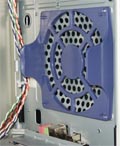CompuCase Tower Cases
Reviewed by James 06.23.2003
Cooling Issues and Modding Potential
The cases both use a traditional negative pressure system via a 120mm back fan, below the powersupply, at least stock. Many, many people are vehemntly opposed to negative pressure systems for reasons that aren't entirely clear. Sometimes I wonder if it may be that its a deep masculine impulse for more power thus driving many to push as much air into a case as possible. The positive benefits from this aren't entirely clear, but the issue can ultimately be left up to you (at least your perception of it), given a few extra dollars for the optional front case fans. On the CI, up to two 80mm fans can be installed, one in the bottom 3.5" drive cage, and one on the very bottom for general case cooling. The LX uses one 120mm fan in the front to cool all 5 harddrives and the case. Well, perhaps the positive pressure enthusiast will have to stick to the CI for their positive goodness. Between the obstructing airfilter and the harddrives, the LX will always be, prima facie, a negative pressure sytem given equally created fan, while the CI has the potential to be positive pressure. . . . Of course, the back fan can easily be removed to make it positive pressure, though this probably would not benefit your cooling much.
Speaking or obstructing airfilters, both cases come with permanent, cleanable airfilters in the bottom of the faceplate. Simply push the plastic button on the bottom side of both faceplates to lift out the silver part of the faceplate which houses the filter. A stiff, notched plastic piece holds the filter in and can be removed by gently pulling on the plastic piece. The filter, however, is not made to keep the computer to clean-room standards, but it would do a decent job of blocking significant amounts of dust.
The fans in these cases are incredibly easy to attach. No screwing required, just push them into their sockets. To remove, pull the 'latches away from the fan' and pull the fan out. The fits are tight enough to prevent vibration, and noise, even from high RPM fans.
 |
 |
 |
| The bottom portion of the front panel is easily removed to expose the filter. | The filter fits easily into its allotted space | The fan holder, the same design for all fans in both cases. |
Not concerned about the quality of the air, but the quantity. Both cases have plenty of room to cut holes for added fanage. The LX is a bit more versatile in this area as it can be cut anywhere on its side panel, as opposed to the CI, where one must worry about the window when cutting. Managing to get a fan onto the CI without damaging the window is an unlikely event. However, the window is flush with the surrounding metal, so having a fan overlapping the plastic and metal could work. In any case, both have plenty of room to fit a fan on top of your case.
More modding potential is of course present. From adding windows to cathode tubes, cutting randomn holes, much can be done to enhance your cases look and feel. The CI, being larger, has room for more stuff. One could easily add another drive cage to its bottom. An 80mm fan housing could also be created for the other drive cage with slits cut into the 3.5" slot covers, but say good-bye to that floppy drive. The quality steel used will make it difficult to cut, but you probably won't have to worry about damaging the metal as you make your cuts. Modding the mobo-side side panel may prove to be difficult as it is not made to be removed from the case, being riveted to the actual chasis. Be careful not to hit a drivebay or powersupply while your cutting.
Security
The LX claims to have added security with the locked handle. The claim may be true as a deterrent for the casual thief, but someone determined will have no problem at all getting into the case. First of all, the front panel comes off easily, with no lock. Hence, all of your 5.25" drive bays could easily be slid out. Furthermore, the lock only works on the top latch, allowing a significant amount of levarge with an entire corner unsecured. I found that I could get to quite a bit of the inside of the case, with no signs of forced entry from the side. Not exactly security. However, this is not necessarily a negative thing, just not as much of a plus. The case is not aimed at a market especially concerned with extreme security. The lock will certiainly help keep little brothers and pesky children (or parents) from getting into your stuff.
| « Overview | Power Supplies » |

